Noble Ranches: Managing Through Drought
The recent drought years have been both rough and rewarding for the Noble Ranches. Here’s how following regenerative principles and making tough decisions have preserved our grassland resources as we care for our livestock.
Drought conditions bring tough decisions on a ranch, in the face of many unknowns. When will it rain again? How long will your grass hold out? Do you keep your herd and buy hay? How deep do you cut if you decide to destock?
For the managers of the Noble Ranches, one goal took precedence and drove a lot of those tough decisions during 2021 and especially 2022: stewarding the grassland resource for the long term.
“Our main focus was to make sure that we’re not permanently degrading the resource,” says Joe Pokay, general ranch manager at Noble. With nearly 14,000 acres to manage over seven
different properties, he and his team followed regenerative principles to make the key stocking, breeding and grazing decisions that got them through the drought period without overgrazing the land or breaking the bank buying hay.
That’s not to say they didn’t take major hits. They reduced the cow herd by about 30%, sold all their steer calves after weaning (usually retained to 900-weights) and didn’t buy stocker animals in the spring to supplement their stocking ranch — normally a large part of the ranch income, Pokay says.
“We decided not to do that because we didn’t have enough forage,” he says. “Our stewardship was screaming at us, ‘please don’t put any more animals out here, ‘cause I can’t take it.’”
So here is how Pokay and his managers listened to the land and rode out the drought the last two years and into 2023, chalking up some wins along with the losses and learning several lessons along the way.
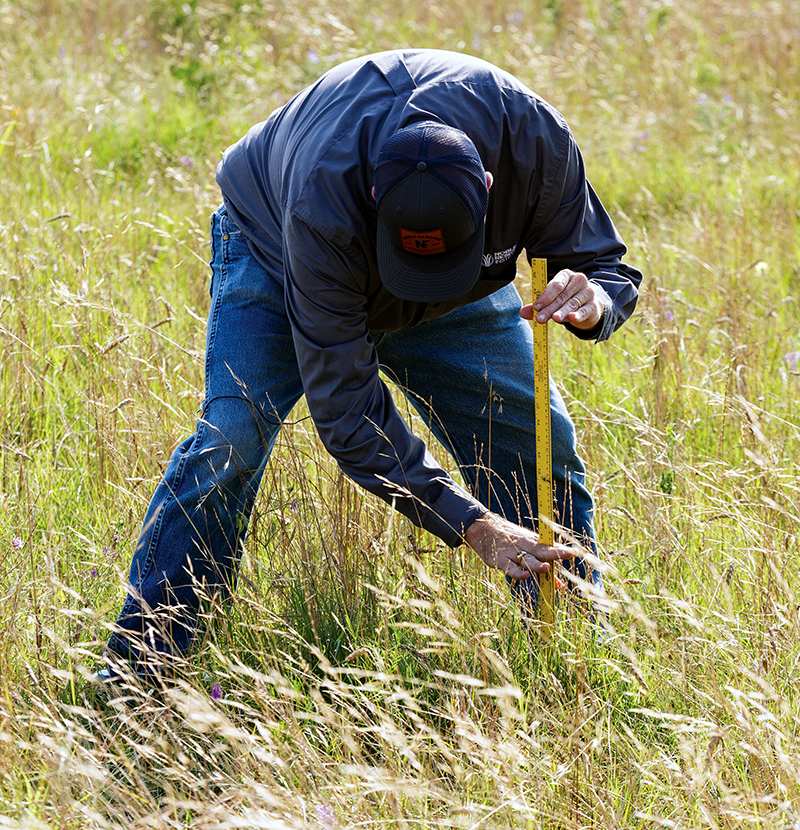
Taking stock of available forage
Every two weeks, Noble ranch managers and staff measure the grass and other forage available in their pastures. Starting out, they clip and weigh the grass as well as use a grazing stick to measure forage height and density.
“Clipping and weighing the grass is a great way to calibrate your eye,” Pokay says. “When you’re doing that so often, you get really good at doing visual estimation.” The measurements then factor into computing how many animal days per acre of grazing are available. After a graze, they estimate and record the number of pounds of forage consumed per acre, which is easier to compare
across ranches than using animal unit days per acre. All grazing information is recorded daily to retain data for summary statistics and future planning.
As Chance Tynes, ranch manager for Noble’s Oswalt Ranch, describes it, when they’re getting moisture and the grass is growing really well, “you have regrowth behind you, so you start adding that up as you’re taking (grazing) it off. Once the fall gets here, and the grass quits growing, that’s when you look at deficit measurements as you go, because you know what you’re going to have to get through all winter long.”
As continued drought became evident in 2022, Pokay says they wanted to be sure to have enough grass on the ranches to
graze the cows and small ruminants all the next winter without having to feed any hay. They also wanted to keep a 50 animal-unit buffer of extra grazing grass. All without knowing for sure how much rain was going to come.
“You really want to be able to know how much forage you have and know where you stand at the beginning of the drought,” Pokay says. “That way you can capture the value of the market before it gets flooded with cows.”

Culling by conception
After crunching all the numbers, the Noble ranches needed to cut the 700-head cow herd by 30% to have enough forage and minimize hay feeding through the winter. Unfortunately, even though they knew that early in the year, a decision they had made to be more in sync with nature worked against them when it was time to destock.
“We very easily could have kept everything, but the ranch would have been in terrible shape this spring,” Pokay says, looking back. “We know that if we abuse our resource … that’s a negative cascading effect that will just keep rippling through into the next year and years after that.”
So the painful decision to destock was made, which he says a lot of people say should be done by selling your oldest cows first.
“But if you’re selling bred cows and keeping open cows, it’s not really helping you for the next year,” Pokay says. “So we decided to cull on conception, and we wanted to cull about 30% of all the cows. We felt we could get a 70% conception rate by shortening our breeding season by two weeks, the result was an average conception of 71.5% across all the cows.
The year before, Noble had changed its breeding and calving timing to later in the year instead of calving in the middle of winter, usually January and February.
“So from our holistic, not drought-induced, management goals, we wanted to move our calving back,” he says, partly to help match when dams have high nutritional requirements while lactating with when the grass comes on in the spring. Because of the drought and the need to destock, they shortened the calving season, as well.
Our stewardship was screaming at us, ‘please don’t put any more animals out here, ‘cause I can’t take it.’
Joe Pokay
“We just decided to pull the trigger and say this is the breeding season now, and the cows that will calve in that season are the ones that’ll get bred in our short breeding season,” he says. “So they sort of selected themselves. If we’d done that in a year that we weren’t forced to sell 30% of the cows, it would be a pretty big hit. But because we had to sell them anyway, we tried to make lemonade out of lemons, I guess.”
But moving the calving back and turning the bulls out later meant doing pregnancy checking later in order to cull open cows, and that had a cost.
“Those 80 days were stressful, because we had a lot more cows than
we had grass for, and we were just waiting to make sure everything was going to work the way we thought it would,” Pokay says. “The more you keep pushing things off till later during the drought, the more people start wholesaling, liquidating cows. And so the longer you’re holding onto the cows, the less valuable they become.”
They didn’t do “terrible” on the cows they sold, “but we would have done a lot better if we could have sold them sooner.”
As mentioned earlier, the Noble Ranches also sold all the steer calves rather than keeping them to heavier weights, and didn’t buy stocker cattle for summer grazing. But they were able to keep most of their heifer calves as a low-cost way to grow their cow herd with desirable genetics.
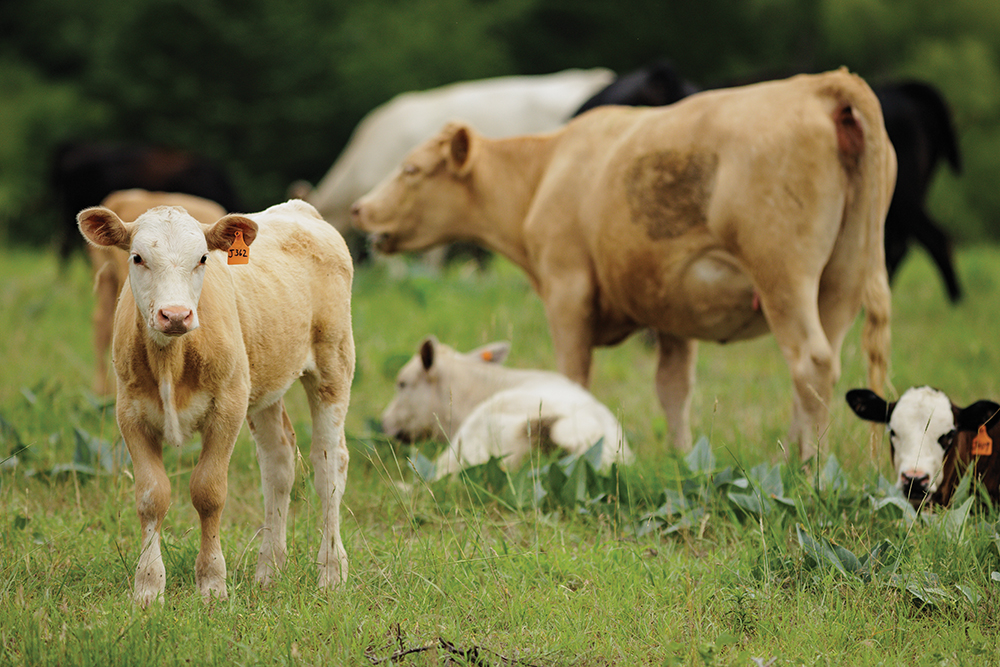
More lemonade out of lemons
On the Oswalt Ranch, which Tynes began managing in January 2023 after 17 years at Noble’s Red River Ranch, he inherited an unusual situation. Because the drought had dried up all the ponds on the east side of the ranch, where water lines were yet to be installed, no grazing took place on that side of the ranch in the dry summer of 2022.
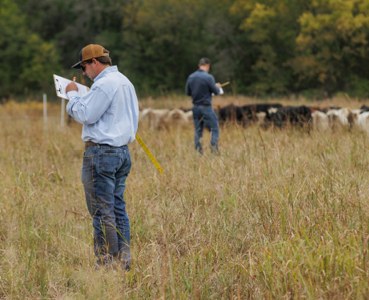
Make a positive impact on your land, your livestock and your livelihood.
Take action now towards a more sustainable and more profitable future.
In early 2023, some rains started to refill the ponds and streams, and some of the new water infrastructure was in place on the east side. The long-rested grass there was plentiful, and winter annuals came up with the rain.
“So we were able to winter our cattle all winter on the east side, and we calved there, all with very little hay,” Tynes says. “I think we fed six or seven bales of hay in all, and that was just during the ice and snow because they couldn’t get to what they needed to graze.
“I guess the drought was a blessing in a way, because it kind of opened our eyes up to what we can do if we save some stockpile grass during the wintertime,” he says. “If we hadn’t had the grass, we would have had to feed probably 20 to 40 pounds of hay a day a piece, and that gets expensive.”
The ranch, which is hilly with a lot of woods and brush, currently supports not only 100 mother cows and 76 yearling heifers, but also about 1,200 nanny goats with kids that grazed behind the cattle in rotation in a lease arrangement between the owner of the goats and Noble.
“We let the cows take the top-best third to half of the grass off and keep them moving, then the goats come in
and clean up under the trees and help clear up some of the brush,” Tynes says.
In June, Tynes says the grass on Oswalt Ranch was responding to the rains enough “that we’ve got enough grass in front of us to probably go nearly all winter long, even if it stops raining now. And we also have water available everywhere now, so we can use smaller paddocks in our rotation and know for sure we’ll have enough forage in front of them to go to spring.”
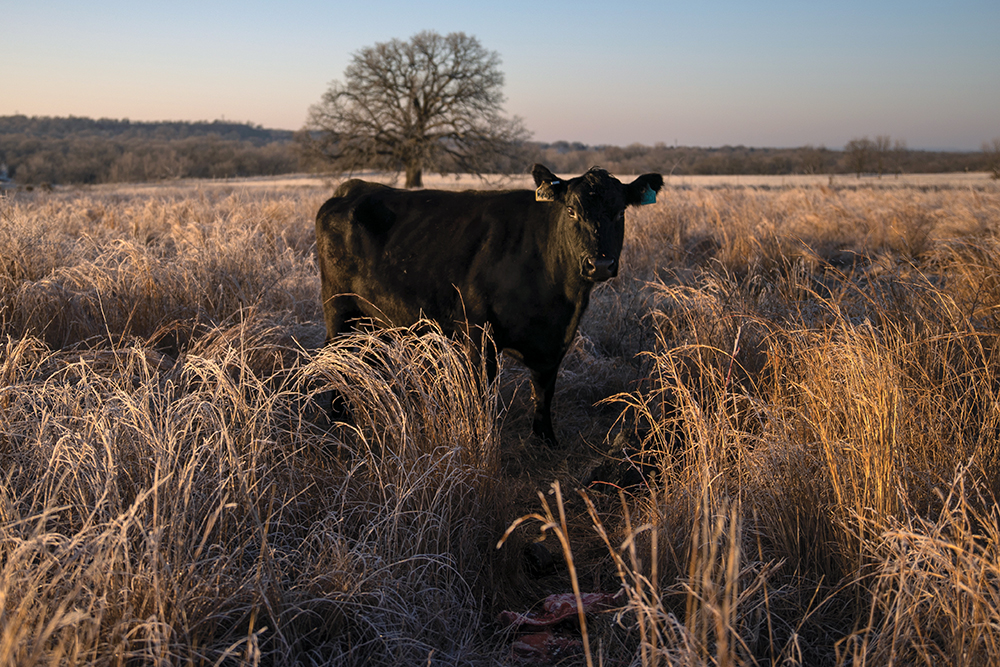
Valuable lessons learned
Even with improved conditions once a drought eases, Tynes cautions against stocking up too quickly. “A lot of people see good rains and the grass growing, and think ‘well, I need more cows; I don’t have enough,’ and buy a bunch of cows. Well, when winter gets here, that’s twice as much hay they’re having to feed if they don’t have any standing grass.”
For Paul Luna, who manages the Noble Headquarters Ranch at Ardmore, the drought year of 2022 changed plans and taught lessons. He was supposed to be starting a grass-fed beef program with stockers, “but we had to kind of put that on hold. A drought year is not a good year to start a grass-fed program,” he says.
He did, however, take care of the cull cows being bred before they were sold, and grass-fed about 50 lamb rams for sale to a butchery in Texas.
“You know, the lamb rams don’t eat as much, so they were easier to feed out,” Luna says. He moves them three or four times a day to keep them up and grazing and “get them a little fatter.”
Being on the city water supply eliminated any livestock water issues at the ranch during the drought, and rotational grazing plus some destocking meant adequate forage to graze all winter long. The only time Luna fed hay was when it was icy, or when he wanted to bale-graze to use livestock impact on bare ground or over briars.
To control briars, he mows over them and sets out the hay, so the cattle can stomp out the briars and deposit fertilizer in the form of manure and urine.
“I’ve done that for like three years, and the briars haven’t come back yet,” he says.
Luna says managing through the drought reinforced valuable lessons.
“Make sure you destock accordingly,” he says. “And don’t overgraze your grasses. Give them plenty of rest, and don’t move the livestock back on to them too quick, or it will hurt the root system of the grass.”
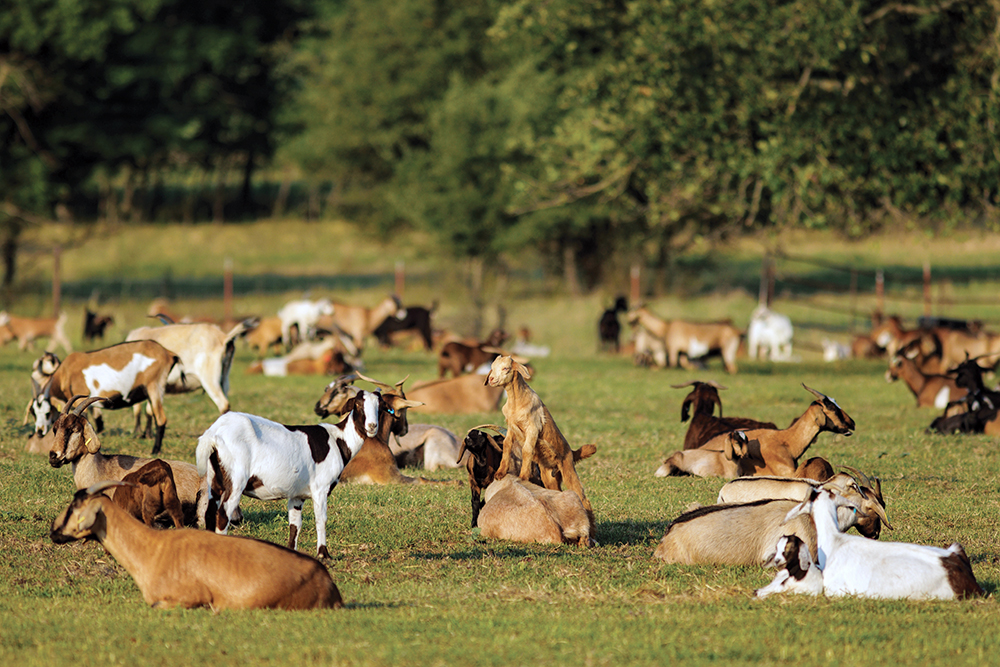
In good shape for the future
As Pokay sums up how things turned out, he counts a lot of positives among the pain.
Using adaptive multi-paddock (AMP) grazing to rest pastures as they could, with stocking levels low enough to avoid overgrazing “had a measurable benefit this spring when it finally did start to rain, because everything was set up to be productive. It wasn’t already set up to be behind again. In May and June, we’ve grown three times as much forage as we grew all of last year, I would say.”
Cash-flow projections were negative for the next year due to destocking, “but we’re probably money ahead, because we still have a good land resource, and we still improved our soil health. Those are things that don’t pay directly, but they have intrinsic value that we capture, even though nobody is really paying us for it.”
He’s glad they kept with their goal of not wanting “to feed our way through the drought, because you never know how long they’re going to last,” he says. “So we wanted to have enough grass plus a buffer so that we could graze the cows all winter and not really have to feed any hay.
“Because that’s the quickest way to go broke, in my opinion — feeding hay during drought.” The Noble Ranches did buy enough hay to have about 40 days of emergency feed, and finding it was hard and expensive. “That was another challenge, just to have that buffer.”
As it turns out, even with buying that feed and dealing with the drought, “our average fed feed per head, which includes salt and minerals and protein supplement and hay, for the whole winter on all the ranches was $104 a head, which is low for a good year,” Pokay says.
“So through our grazing management, moving our breeding season back and the culling that we did, we decreased our feed cost per head in a drought, which is pretty incredible.”

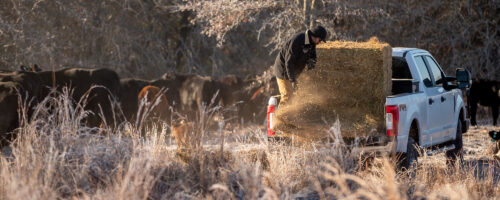
Comment